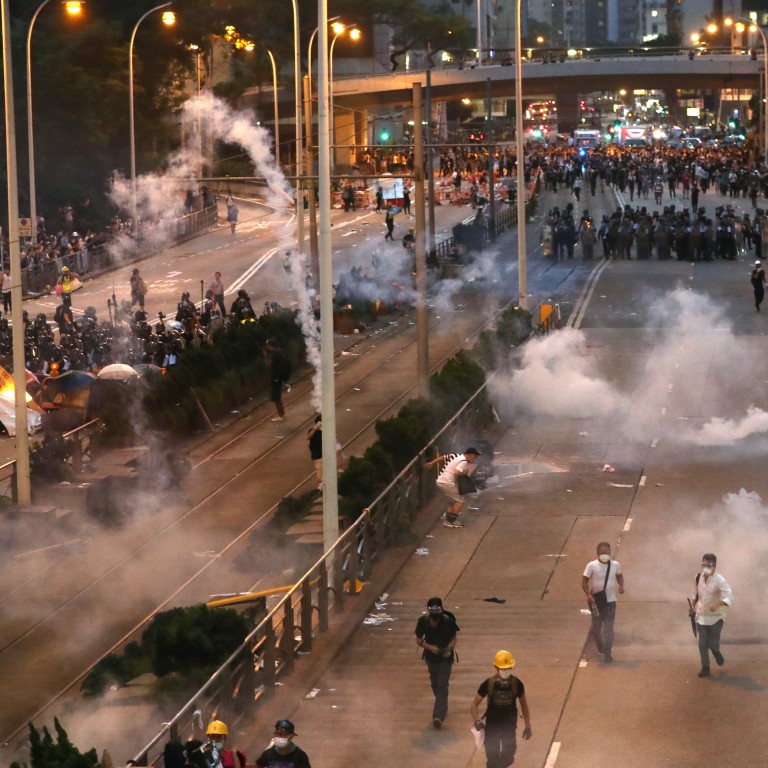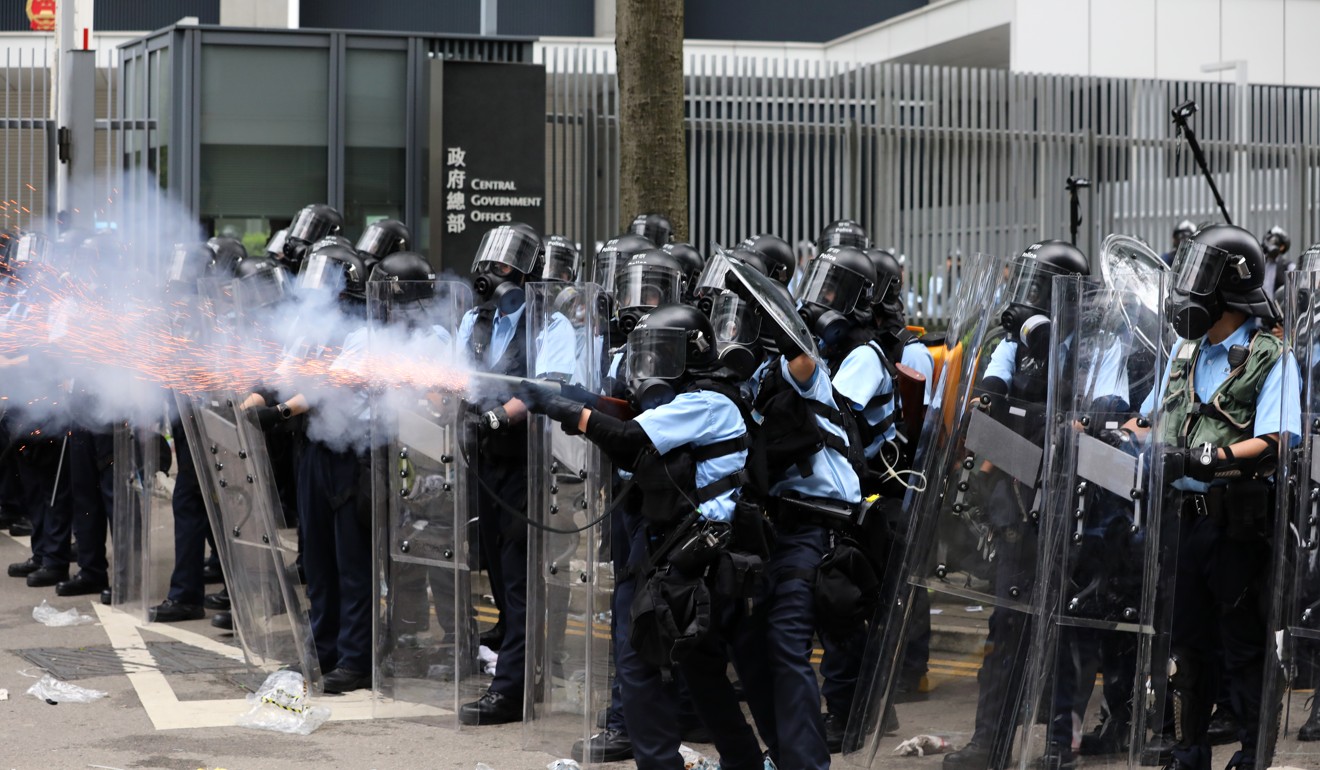
Eleven arrests, double the tear gas fired during Occupy movement and 81 injured: police chief paints disturbing picture of Hong Kong extradition bill protests
- Commissioner of Police Stephen Lo said officers did not use excessive force and that anti-riot weapons they brought out were in line with overseas standards
- Clean-up crews moved in on Thursday to clear roads full of trash, metal barriers and bricks
Hong Kong’s police chief painted a damning picture of rioting on Wednesday by protesters opposed to the government’s extradition bill, revealing that 11 people had been arrested and that his front line officers had fired more tear gas rounds than were used during the 2014 Occupy demonstrations.
In a postmortem on Thursday of the clashes between officers and protesters who had surrounded the Legislative Council building and administrative headquarters the day before, Commissioner of Police Stephen Lo Wai-chung said more than 150 rounds of tear gas had been fired – almost double that on the first day of the Occupy demonstrations – and about 20 beanbag rounds, as well as “several” rounds of rubber bullets.
Parts of the city where the violent clashes took place resembled war zones on Thursday morning as clean-up crews moved in to clear roads full of trash, metal barriers and bricks.
There was no meeting at the Legco complex after the previous day’s clashes forced the cancellation of a full council session to begin the second reading of the highly contentious bill, which would allow the transfer of suspects to mainland China and other jurisdictions the city has no extradition deal with.
Did police use excessive force to deal with Hong Kong protests?
Lawmakers were told the meeting would not resume on Friday either, and there was no word on Legco president Andrew Leung’s intention to finish a 61-hour debate and put the bill to a vote as early as Thursday next week.
The pro-democracy bloc is organising another massive march on Sunday and another general strike the next day to ramp-up the pressure on the government.
Mistrust in mainland China’s legal system and human rights record has triggered a public backlash from lawyers, politicians, local and overseas business groups, teachers, students, social workers and Western diplomats, who fear political and religious dissidents could be targeted.
Facing harsh criticism about Wednesday’s police crackdown on protesters, most of them students and youths, Lo insisted that his officers had not used excessive force. He said the anti-riot weapons they brought out were on par with those used by overseas law enforcers dealing with similar situations.
“I have not seen such scenes for a long time,” the police chief said as he condemned the violence and tried to justify the level of force as necessary to control the situation, disperse the crowds and protect those in the compound.
“We the officers and you are all Hong Kong people. And we share the same vision to maintain law and order, and it is our responsibility to make Hong Kong a safe place for people to live in,” he said.
Hong Kong is in shock after seeing the roads around the legislature and government headquarters turned into tear gas-filled battlefields reminiscent of the chaos last seen in 2014, when police fired a total of 87 rounds of tear gas to disperse protesters on a civil disobedience campaign to demand greater democracy.
There were no reports then of police using rubber bullets or beanbag rounds when protesters occupied the roads for 79 straight days.
The Hospital Authority said 81 people – 57 men and 24 women aged 15 to 66 – were injured in Wednesday’s violence.
As of 10pm on Thursday, five people – three men and two women – were still in hospital in stable condition and 75 had been treated and discharged. The condition of one person was unclear.
Those arrested were accused of disorderly behaviour in a public place, unlawful assembly, assaulting police officers and other riot-related offences, Lo said.
Teacher among four arrested in public hospitals after clashes
Among them were two university students and a teacher from the elite Diocesan Girls’ School, who had suffered an injury above his right eye and was picked up by police along with three others at public hospitals. One of the four was unhurt but was arrested while accompanying an injured friend seeking medical treatment.
More than 100 reporters wore helmets, masks and vests to a press conference held by Lo, in protest against claims of violence and harassment by police against journalists. The Hong Kong Journalists Association said that it had received more than 15 complaints from the night.
Lo apologised to reporters if they felt they were mistreated but added that he had always treated the press in a polite manner.
“I feel sorry if you were treated in an impolite way. But I hope you will show some understanding as many of my officers worked more than 30 hours like you guys. It is from my heart,” Lo said.
In an interview with Britain’s public broadcaster, the top Chinese envoy to London, Liu Xiaoming, dismissed suggestions that Beijing had instructed Hong Kong to amend the city’s extradition laws.
Liu also defended the police use of force, saying it was defensive in nature and intended to restore order, and that “forces inside and outside of Hong Kong” were trying to take advantage of the situation to “stir up trouble”.
Opinion: Extradition row makes Singapore look attractive for businesspeople
“No. Why should we ask them to drop it,” he replied when asked whether Beijing would tell the Hong Kong government to shelve the bill in light of the public backlash.
Chief Executive Carrie Lam Cheng Yuet-ngor, who initiated the push for the bill, has already made it clear she will not back down, having secured the support of the pro-establishment majority in Legco to get it passed.
In another challenge to Lam, former deputy broadcasting director Tai Keen-man, who was her election campaign spokesman, signed a petition initiated by the Hong Kong Council of Social Science, demanding the chief executive shelve the bill.

In Beijing, foreign ministry spokesman Geng Shuang also weighed in to defend the handling of the protests by Lam’s government.
“I think any act that undermines Hong Kong’s prosperity and stability goes against Hong Kong mainstream public opinion,” Geng said at a regular press briefing. “We support the Hong Kong government for dealing with the situation in accordance with the law.”
Businesses taking a hit near site of anti-extradition clashes
As Hong Kong picked up the pieces on Thursday morning, roads blocked by barricades set up by the protesters were reopened to traffic. The city’s railway operator also reopened Admiralty station, a major transit hub that was closed during the peak of Wednesday’s clashes to deny demonstrators their primary access to the protest site.
But hundreds of them were back on Thursday, assembling at the public park next to the Legco complex, some singing hymns, while police stood watch.
The city is facing the possibility of more trouble, with the Civil Human Rights Front announcing plans for another mass rally on Sunday afternoon to oppose the bill and condemn the police crackdown.
The front is an umbrella group of pro-democracy activists that is claiming a historic turnout of more than a million people at its June 9 protest march against the bill.
Former lawmaker Lee Cheuk-yan laid the blame squarely on the chief executive for “provoking” the public with the bill.
“We condemn Carrie Lam for ordering police to use excessive force and violence against demonstrators,” Lee said, adding that he expected a similar crowd to last Sunday’s mass rally.
The front also called for a public strike and class boycott by students on Monday to join another major rally outside Legco at 10am.
Lee and members of the front also joined 15 pan-democratic lawmakers to petition the chief executive outside her official residence at Government House, seeking talks with Lam.
Opposition lawmaker Claudia Mo, convenor of the pro-democracy camp, said they wanted a promise from Lam that excessive force would not be used against protesters in future.


